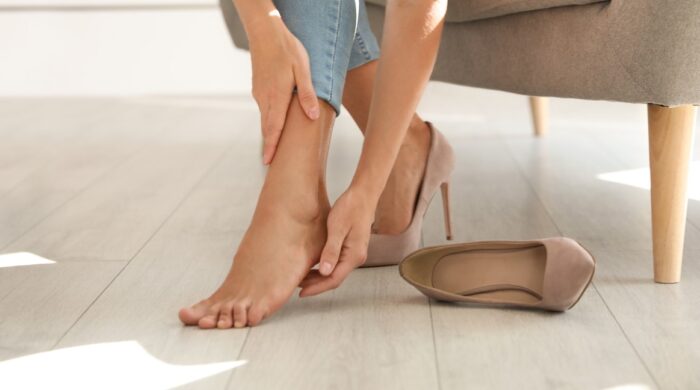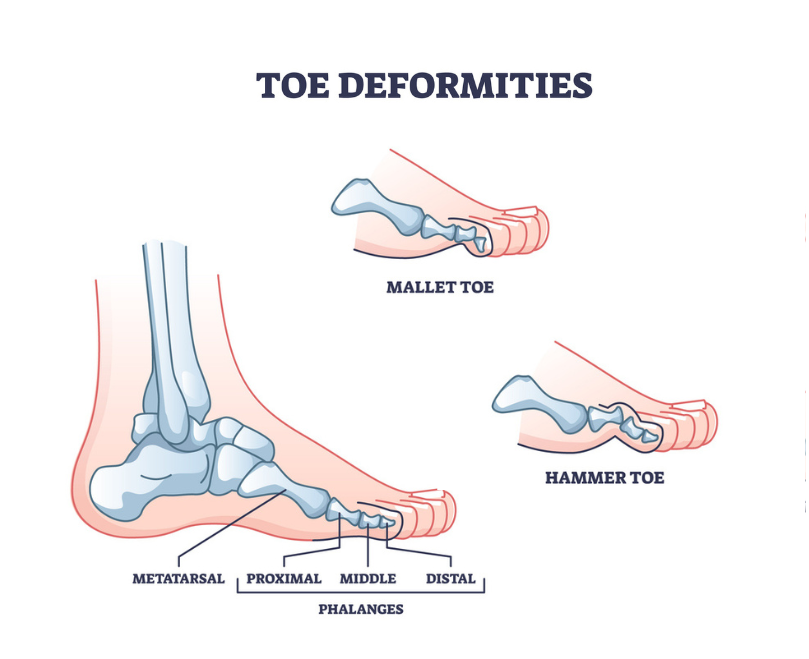Many of us go through each day without thinking about our feet, taking them for granted. It’s only when something goes wrong that we realize just how important our feet really are.
For example, hammertoes and mallet toes are common foot conditions that can cause discomfort and pain when walking. While the two may seem similar, the main difference is where the toe joint is affected. For both adults and children, hammertoe and mallet toe should be evaluated by a Podiatrist for early treatment and correction.
This article will cover the similarities and differences between hammertoes and mallet toes, as well as the causes, treatment options, and when to seek help from a medical provider.
Overview of Hammertoe and Mallet Toe
Hammertoe and mallet toe are foot issues that cause a bend in a toe or multiple toes. Hammertoe is a bend in the second, or middle, joint of the toe. Mallet toe is a bend in the third joint of the toe, closest to the toenail. These conditions often result from an imbalance in the ligaments that hold the toes in proper alignment.
Symptoms of hammertoe and mallet toe include pain when wearing shoes, difficulty moving the affected toe(s), and stiffness. Sometimes, redness and swelling occur. Corns and calluses may also develop from the toes repeatedly rubbing against shoes.
Foot problems can affect a person’s walking, posture, and overall movement.
Women are more likely to develop hammertoe or mallet toe than are men, often because they wear shoes with higher heels. Additionally, patients with diabetes or rheumatoid arthritis are at higher risk of developing foot conditions.
It’s important to note that hammertoe and mallet toe may worsen if left untreated. Seeking medical advice from a WWMG Podiatrist can help you find effective options for treatment.
Causes
The causes of hammertoe and mallet toe include:
- Wearing shoes that don’t fit well – high-heeled shoes or footwear that’s too tight can crowd toes and cause them to curl.
- Foot injury – a toe that has been stubbed, jammed, or broken.
- Imbalance of the toe muscles – puts pressure on the tendons and joints.
- Health conditions, such as arthritis and diabetes – increase the risk of having foot problems.
- Genes and family history may also play a role.
Types of Hammer Toe
A hammertoe is a contracture, or bending, of the toe at the middle joint of the digit. This bending causes the toe to appear like an upside-down V when looked at from the side. Any toe can be involved, but the condition usually affects the second through fifth toes.
There are two types of hammertoe:
Flexible
Flexible hammertoe is when the toe is still moveable at the joint. It is less serious because it can be diagnosed and treated to prevent it from becoming rigid.
Rigid
Rigid hammertoe is more serious than the flexible condition. Rigid hammertoe is when the tendons have become tight, and the toe joint is misaligned and can’t move. This occurs most often in patients with severe arthritis, or in patients who wait too long to seek medical help. With rigid hammertoe, surgery is the usual course of treatment.
Anatomy of Mallet Toe
Mallet toe refers to a toe with an upward bend at the joint closest to the toenail. It may cause the toe to look curled instead of lying flat.
Mallet toe develops when a toe is repeatedly forced upward. It occurs mostly in the second toe (the one next to the big toe), but can also affect the third and fourth toes of the foot.
Symptoms to Look For
The symptoms of hammertoe include:
- An upward bend in the middle joint of a toe
- Restricted or painful motion of the toe joint
- Redness and swelling at the bent joint
- Pressure at the top of the bent toe when wearing shoes
- Formation of corns on the top of the joint
- Pain in the ball of the foot at the base of the affected toe
The symptoms of mallet toe include:
- An upward bend in the joint of a toe that’s closest to the nail
- Redness and swelling of the affected toe
- Corns or calluses on the bent part of the toe
- Toe pain when wearing shoes or walking
- Toe sores or ulcers, especially in people with diabetes
- Toenail thickening or changes
Prevent Problems by Choosing the Right Shoes
Buying supportive shoes can help prevent foot problems. Avoid wearing shoes that are too tight, too narrow, or have pointed toe boxes that pinch or crowd the toes. Choose footwear with a low heel and square toebox to take pressure off your toes.
Have your size checked by a sales professional. Shoe size — especially width — can change with age. Measure both feet and buy for the larger foot. Shop at the end of the day, because it’s common for feet to swell as the day goes on.
Be sure shoes are comfortable before you buy them. Buy shoes that fit right on the first try. A shoe repair store might be able to stretch shoes if they’re tight, but it’s better to buy them to fit at the start.
For kids, it’s never too early for proactive prevention! Children should have their feet measured, size checked, and shoes properly fitted on a regular basis, since developing kids can outgrow shoes rapidly.
Non-Surgical Treatment
The severity of hammertoe and mallet toe can vary for each patient, but identifying the issue early is important in order to avoid surgery.
The first step to effective treatment is seeing a Podiatrist for a complete evaluation and diagnosis of your specific condition. A Podiatrist can offer advice and recommendations on how to reduce foot pain and restore normal function as much as possible.
Non-surgical treatment options may include:
- Padding and Taping. For hammertoe and mallet toe, the first steps in a treatment plan are often padding and taping techniques. Padding the affected toe with small cushion devices minimizes pain, while taping can relieve the stress on the joint.
- Shoe Recommendations. The Podiatrist may recommend changing the type of shoes you wear. Finding shoes that fit properly with a wide toe box can make a positive difference.
- Medication. Anti-inflammatory medications and cortisone injections can be prescribed to ease acute pain and inflammation caused by the joint deformity.
- Custom Orthotics. Additionally, orthotics, custom shoe inserts prescribed by your podiatrist, may be useful in improving foot function. A custom orthotic can reduce symptoms and prevent the worsening of the hammertoe deformity.
- Physical Therapy or Physiotherapy. A prescribed exercise regimen can help strengthen and straighten the toe muscles.
Types of Toe Surgery
The severity of the foot condition will determine if surgery is needed. Severe or rigid toe joint deformities may not respond to conservative therapies. Some patients will need surgery to restore proper alignment in the toe joints.
Surgical options include:
- Arthroplasty: Removing part of the bent toe bone and realigning it.
- Tendon release: Cutting a tight toe tendon to allow the toe to lay flat.
- Tendon transfer: Moving the tendon in the toe to another part of the foot, to force the toe to straighten.
- Joint fusion. Removing a small portion of the bone in the toe to extend the joint. The surgeon may use a wire or pin to hold the bones in place.
A Podiatrist will discuss treatment options and recommend the surgery most appropriate to your foot condition.
After foot surgery, be aware that recuperation takes time, and swelling and discomfort are common for several weeks following a procedure. WWMG’s Podiatrists can perform foot surgeries and prescribe the correct medication and recovery plan to help you safely manage any post-surgical pain.
When to See a Doctor
The feet and toes help us work and play and pursue all the activities we enjoy. Foot problems can have a big impact on your quality of life, by affecting your ability to walk, do work, and to enjoy leisure activities.
If you’re experiencing pain, soreness in your toes, or difficulty walking, don’t wait to seek medical attention. WWMG’s experienced Podiatrists will assess your foot condition and partner with you to map out a customized treatment plan. Your Podiatrist will recommend which type of treatment, or if surgery, is right for you.
Early detection of hammertoe and mallet toe can help you get the treatment you need to reduce pain and significantly improve your quality of life. Request an appointment with WWMG’s Podiatry team today.

